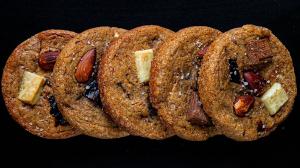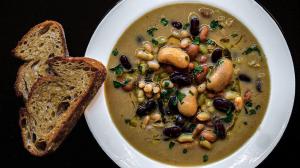Or the “1-2-5” COOKIE since all the main ingredients each weigh 125 grams and are easy to remember, even the little added extras measure 1¼ tsp each which is also 1,25 teaspoons right ? And the baking time is 12 ½ minutes too.
I also tried baking them at 125°C and then let them sit in a turned off oven but that’s where the magic and coincidence stops since the result is too cakey but not over-baking them is the most important thing and probably the most difficult step because you’ll be tempted to say to yourself, okay just a minute or two more would be better but “oh how wrong that is !”.
Cookie characteristics : crispness, chewiness, softness, hardness, thinness and thickness. All of these textural and/or physical characteristics are partly dependent on the ingredients but even more so on the baking time as well as the temperature of the cookie dough before baking it and the baking shape, whether spherical or slightly flattened.
It’s a question of personal tastes and what you’re in the mood for because sometimes you want thinner and crispier cookies, sometimes you want thicker and chewier cookies, or perhaps something in between or a combination of both ? All of this is possible with the same recipe but modifying the pre-baking and baking techniques.
Using the same recipe and the same batch of 24 cookies, I baked 4 batches of 6 cookies each to test different results. The dough had rested for 24 hours in the refrigerator (which is important for the dough to mature and develop its final texture) before shaping the chilled dough into golf ball-sized spheres, then I slightly flattened them, topped each with more roasted almonds and chocolate chunks and then inserted them into silicone rubber molds (which isn’t necessary but easier for me than trying to slip a large baking tray into my small freezer) and I flattened them further and froze them for just a few hours and then popped them out like ice cubes and placed them in freezer bags.
Each of the batches were cooked at 175°C for exactly 12 ½ minutes but the results were different for each because of the dough temperature before baking them and the decision to limit their freedom to spread out or not by using the silicone rubber mold or metal rings (with no bottoms).
The results were as follows :
1-baking cookies that have thawed for 25 minutes at room temperature before baking yields a larger and flatter and crispier cookie about 10 cm in diameter and almost 1 cm thick in the middle and very thin at the edges;
2-baking slightly frozen cookies that have thawed for only 12 ½ minutes while the oven is preheating, yields slightly more compact, slightly domed cookies that are thicker and chewier in the middle and thinner and crispier at the edges and measure about 9 cm in diameter and 1,25 cm thick in the middle with moderately thin edges;
3-baking slightly frozen cookies that have thawed for only 12 ½ minutes while the oven is preheating, but with a metal 8 cm ring around each to control the spread, yields compact, quite even cookies that are equally thick and chewy everywhere and measure 8 cm in diameter and 1,50 cm thick throughout;
4-baking slightly frozen cookies that have thawed at room temperature for 25 minutes in small silicone molds with openings of 6 cm each in diameter (and the same mold that was used to freeze them) yields moist (but not cakey), very compact and very chewy cookies that are approximately 2 cm thick everywhere and quite decadent;
All are very satisfying and taste the same but it’s a question of preferences of textures and overall appearance.
Whatever you decide, I have a preference for option number 3 as my favorite and option number 4 as my second favorite. I like controlling the spread and ending up with an evenly thick and chewy cookie throughout its entirety.
To resume, almost frozen dough is optimal, just let it thaw a little bit so the outside doesn’t burn or overcook before the inside has baked and to end up with evenly sized cookies, just use metal rings that are about 33% larger than the pre-shaped dough balls or discs (about 1 cm more per side).
And by all means, I repeat : “do not overcook them” because even though they may still be soft to the touch and look un-baked after 12 ½ minutes, they will continue to cook as they leave the oven and until they cool down (trust me, it’s what I did with the first 2 batches several weeks ago, with around 2-4 minutes of over- baking, before re-testing these one here, and they were too hard and dry). Every extra minute makes a big difference.
The only thing I may do differently next time is to replace 125 grams of chocolate with 125 grams of dried fruits like raisins or cranberries or even candied cherries (if I’m feeling kind of “fancy”).
Anyways, see you at the next batch ! . . . :)





















